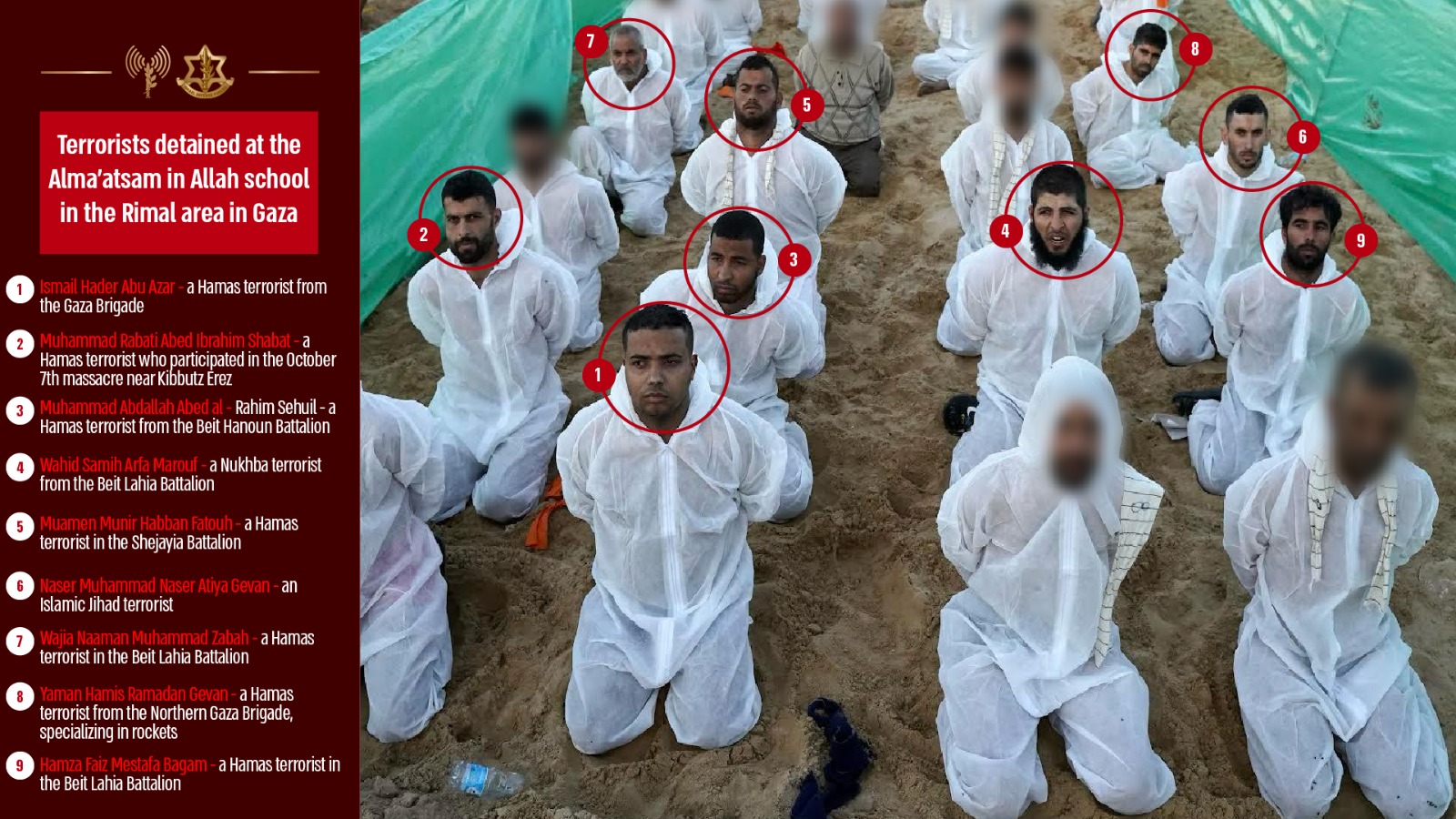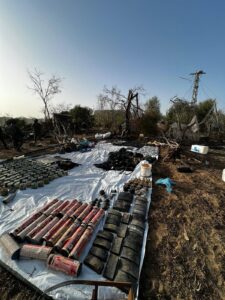As CAMERA has repeatedly documented, there is a pattern of CNN reports lobbing horrific allegations at Israel based on exceedingly thin evidence and lots of insinuation. It’s a standard, or practice, akin to tabloid journalism – a standard certainly not appropriate for serious journalism or serious accusations like that of war crimes.
The latest example comes from a February 13 article entitled “‘We were walking in water, sand, mud’: Palestinian women describe terror of 12-mile escape on foot from Gaza City,” by Abeer Salman and Mohammad Al Sawalhi. The gist of the story, based on the claims of four women in Gaza, is that they and other Gazans were besieged and almost buried alive in a building in al-Rimal neighborhood of Gaza City by Israeli forces before the women and children were forced to walk eight hours south to Deir al-Balah while the men were “abducted.”
As is all too common in such CNN articles, there is heavy use of suggestive language implying Israeli cruelty.
For example, the authors repeatedly imply that Israeli forces were shooting civilians without explicitly saying so. For example, they quote one of the women saying, “We opened the door for them and asked them not to shoot. We told them we only have kids, but they kept shooting.” Another supposedly told CNN that “Israeli forces were firing towards them as they walked” after leaving the building in al-Rimal, while a third also supposedly told CNN that “they could see Israeli missile boats off the coast and were fearful they would be fired on.”
Yet, despite all this apparent shooting, the article never says whether anyone was actually killed or wounded. Surely the journalists would have mentioned it had any of the civilians actually been shot by Israeli forces in these instances. Either Israeli forces are murderous, but terrible, shooters, or something else is going on.
In a similar apparent effort to depict Israeli forces as cruel, the authors insinuate that the IDF was trying to demolish buildings with civilians inside. One of the Gazans from the al-Rimal building is quoted saying, “We heard the houses collapsing on the heads of people” and that “[t]hey were about to bury us as well, but we begged them to let us out.”
The evil Israelis, it’s implied, were knowingly going to bury them alive inside the building.
But this depiction makes little sense when one looks more closely at the order of events depicted by the article:
- Israeli troops arrived at the building and told those sheltering inside to leave, explaining it would be “blown up within 10 minutes,” according to interviewee Hoda Harb.
- According to interviewee Israa Hassan Ahmed al-Ashkar, the Gazans “did not want to leave the building, but the Israeli military began intensive bombing in the immediate area. They ‘destroyed the building entrance and came upstairs…’”
- Then, according to al-Ashkar, “We heard the houses collapsing on the heads of people,” she claimed, and then the ruins of the buildings were bulldozed.
- Finally, said al-Ashkar, “They were about to bury us as well, but we begged them to let us out.”
Read together, we’re being told that Israeli troops wanted to evacuate those taking shelter (they “told those sheltering inside to leave”) but also wanted to bury them alive inside (“They were about to bury us as well”) a building which the soldiers were themselves inside of (“[They]…came upstairs”). We’re also told that the Israeli forces wanted to blow up the building within 10 minutes, but before that, they had enough time to blow up and bulldoze other buildings.
It’s bad journalistic writing by authors either incapable of crafting a clear, coherent story or intentionally trying to obscure the story in an effort to mislead readers.
The holes in the story would perhaps make more sense had the authors provided additional relevant context.
Consider these three crucial bits of context that should have been mentioned in the article, but weren’t. Each would have provided readers with important information to understand what might have actually happened.
1) Al-Rimal neighborhood is a known Hamas “nest of terror.”
The CNN authors carefully avoid the important question of who, exactly, the Israeli forces were shooting at; readers are only told they were shooting. The omitted detail that likely would have shed light on this question is that al-Rimal neighborhood is well-known for being a “nest of terror.”
From the very beginning of the war, Israeli officials were identifying al-Rimal as one of the key “terror hubs” (see, e.g., here and here). Since then, Israel has provided substantial evidence of terrorists having embedded themselves in and underneath civilian infrastructure. In mid-November alone, troops located approximately 35 tunnel shafts in the area along with numerous military posts and weapons in residential areas. In early December, troops found terror infrastructure and a large number of weapons and military equipment inside Al-Azhar University, along with a tunnel running from the campus to a school a kilometer away. A week later, troops found Hamas terrorists hiding inside two schools in al-Rimal neighborhood. Just days later, Israeli forces killed and captured terrorists in yet another school in al-Rimal neighborhood, including one who had participated in the 10/7 massacre. Shortly after, the IDF uncovered the massive amount of Hamas terrorist infrastructure in Palestine Square, located in al-Rimal, including command and control centers in buildings and terror tunnels located amongst residential buildings, commercial buildings, and even a school for deaf children. In another incident, Israeli soldiers were saved from an ambush by a terrorist lying in wait inside of a building in the area by an Oketz Unit canine named Toy, who bravely neutralized the terrorist.

An IDF infographic providing information about terrorists found in a school in al-Rimal neighborhood in Gaza.
In fact, based on one map produced by the IDF, one of the buildings in which they found a terror tunnel back in December was located just a few blocks away from the building that is the subject of CNN’s article. Several blocks in the other direction, Hamas terrorists had barricaded themselves inside the Blue Beach Hotel, launching missiles at Israeli forces, in early January. The IDF then found inside the hotel seven tunnel shafts, as well as a large quantity of weapons and drones. Given the estimates about how many buildings have contained terrorists, terrorist equipment, or terrorist infrastructure, it is almost guaranteed that even more was found in the vicinity as Israeli forces approached the building in question.
Despite the abundant evidence of Hamas having systematically embedded itself in civilian structures in the area, the journalists demonstrate zero interest in this crucial context. The authors include only a generalized, boilerplate statement from the IDF about operating against “Hamas strongholds” – hidden halfway through the article – as if that absolves them of their responsibility to investigate and report about this critical aspect of the story themselves.
But if it turns out, as seems highly likely, that those incidents of “shooting” referenced by the Gazan women occurred because there were Hamas or other Palestinian terrorists in the vicinity, then the authors’ decision to omit this context becomes indefensible.
2) Hamas has been repeatedly caught exploiting civilian shelters.
A related piece of context, omitted by Salman and Al Sawalhi, is the documented pattern of Palestinian terrorists exploiting civilian shelters, like the building in question, for military purposes in Gaza. Among the incidents that have been documented during the current war:
- A school in Jabaliya, serving as a civilian shelter, in which troops of the 551st Brigade located weapons belonging to Hamas terrorists. (Times of Israel, December 21)
- In northern Gaza, a building in which civilians were sheltering also contained a large cache of weapons used by Hamas, including “explosive belts adapted for children,” “dozens of mortars” and “hundreds of grenades.” The building was notably located near a school, a mosque, and a clinic. (Times of Israel, December 24; see also images of the weaponry found at IDF, December 24)
- In the Sheikh Radwan neighborhood of Gaza City, Hamas terrorists were found in a school serving as a shelter. A cache of weapons was also found inside, including assault rifles, grenades, and other explosive devices. (Times of Israel, December 24)
- In al-Bureij, troops of the 188th Brigade were fired on by terrorists hiding inside of a school sheltering civilians. (IDF, December 30 (see also video here))
One is left to wonder whether something similar occurred at the building in al-Rimal. Were the explosions nearby because the IDF was fighting terrorists? Did the IDF demolish the building because there was terrorist infrastructure inside? Were terrorists using the building for military purposes in some other way?
It would amount to journalistic malpractice if the authors did not even bother to ask the witnesses about this. Assuming they did, why, then, would they not mention this in the article? Given the article includes the allegation that the Israeli forces “abducted” the men in the building, don’t the journalists have a responsibility to investigate why they were detained?
3) The IDF had been urging them to evacuate for nearly four months.
Israel had been calling on Gazan civilians to evacuate northern Gaza, including al-Rimal neighborhood, for nearly four months. As far back as October 13, when conditions were much better, the IDF was “call[ing] for the evacuation of all civilians of Gaza City from their homes southwards for their own safety and protection and move to the area south of the Wadi Gaza…” In that same announcement, the IDF cited the exact reasons mentioned above: “Hamas terrorists are hiding in Gaza City inside tunnels underneath houses and inside buildings populated with innocent Gazan civilians.”
But the IDF was warning residents of al-Rimal neighborhood more specifically even earlier than that. The IDF was already sending warnings to residents in the area to evacuate as early as October 10, as the neighborhood was a known “power base” for Hamas and thus was one of the areas targeted by airstrikes early in the war.
Perhaps those CNN spoke to simply were simply unable to evacuate at any point during those four months for one reason or another. But why did the authors not mention that the IDF had been trying to get civilians to leave the area for a long time for the stated reason of getting them out of harm’s way?
All of this omitted context, and all of these unexplored questions, point to either exceedingly lazy or intensely biased journalism. Neither is a good look for the network, which is more than capable of producing excellent journalism.

